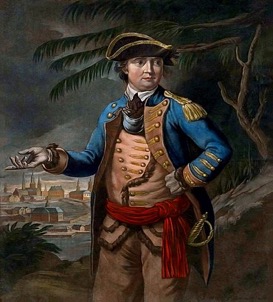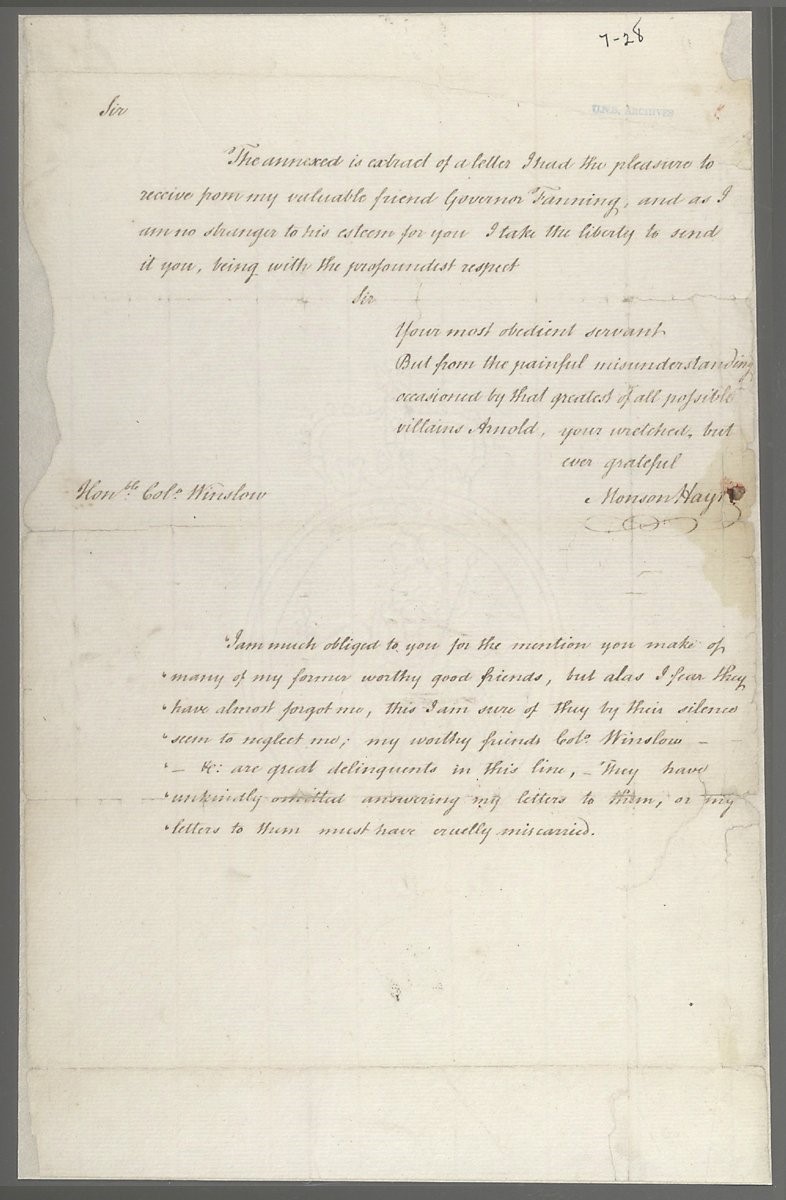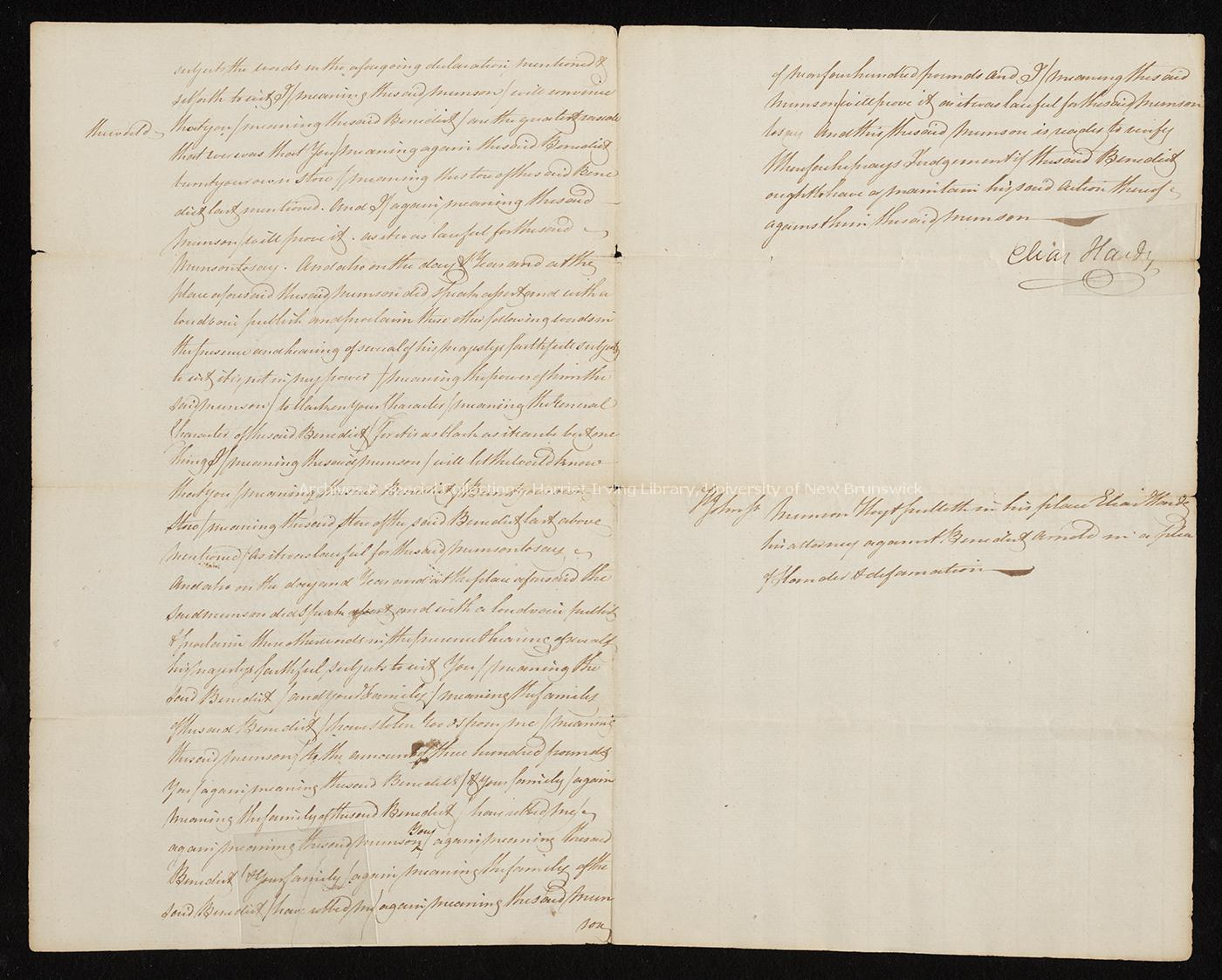- Submitted on
- 7 comments

In May of 1779, Benedict Arnold informed the British of a planned American invasion of Canada, and from then, his name became synonymous with the word “traitor”.
Benedict Arnold (1741-1801) was a Major General in the Continental Army under George Washington during the American Revolutionary War. Some of the stories of Arnold’s wartime heroism and shenanigans have been told in the Major Andre, Vanderbeck and Jonathan Odell Atlantic Loyalist Connection blog posts.
At the end of the Revolutionary War, Arnold moved back to London for a brief period, and then sailed for Saint John, New Brunswick, sometime around 1786 (he would stay until 1791). There, Arnold was involved in a West Indian trading business with his son Richard, and Monson Hayt [also spelled as Munson Hoyt], a former Loyalist officer from New York who served in the Prince of Wales American Regiment.
While in Saint John, Arnold initiated a series of legal actions, not sparing his friends and fellow Loyalists such as Edward Winslow. Legal wrangling was dear to Arnold’s heart. According to Barry K. Wilson, author of Benedict Arnold: A Traitor in our Midst, the minute books of the New Brunswick Supreme Court show that, during his short stay in NB, Arnold was in court 50 times!
Hayt and Arnold soon dissolved their partnership and became involved in a complicated series of legal actions. Hayt had borrowed money from Arnold and had given promissory notes for which he was unable to make payments. As a result, Arnold had Hayt arrested and took him to court to get back his money (to the tune of a little over 2,500 pounds). In a note from Hayt to Winslow, Hayt calls Benedict Arnold “that greatest of all possible villains.”

The most significant of Benedict Arnold’s suits was against his previous business partner. On July 11, 1788, the building used by Arnold and Hayt to store their merchandise burned to the ground. Benedict Arnold’s son Henry almost lost his life in the conflagration, as he often slept in that building.
Hayt publicly stated that he thought the fire had been deliberately set by Arnold for the sake of the insurance money. Arnold sued him for slander. In an article written in 1958 for the Atlantic Advocate, Fredericton lawyer J. J. Fraser Winslow called this “the first slander case in New Brunswick.”
In the plea put in by Monson Hayt regarding the statements which began the Arnold v Hayt slander case (New Brunswick Supreme Court July 17, 1790), Hayt proclaims: “I will convince the Court that you are the greatest rascal that ever was, that you burnt your own store, and I will prove it.”

Benedict Arnold hired Ward Chipman to represent him. Chipman, a graduate of Harvard, was solicitor general of New Brunswick (1784-1808) and had written the charter for the City of Saint John. Hayt engaged Elias Hardy, a prominent Saint John lawyer.
The case was tried on September 7, 1791 in the New Brunswick Supreme Court with a jury of 12 men. The court was held in an Episcopal church on Germain Street. Hayt’s lawyer was restricted to asking only questions related directly to the case and that would not “besmirch” Arnold’s reputation.
The court records state: “After the evidence for the defence was all in, the Plaintiff called witnesses to rebut it, two of them being his sons (Richard and Henry) who were in the store at the time it was destroyed by fire.” Arnold won the slander case against Hayt but received only a small amount of the £5000 he had claimed in damages.

Benedict Arnold and Monson Hayt fonds MG H 3, File 8, UNB Archives & Special Collections
Shortly thereafter, a group burned Arnold in effigy in front of his home. Can one blame the Arnold family for leaving Saint John and sailing back to London?
Stay tuned next week for Part II: How did UNB Archives & Special Collections come by documents related to the Benedict Arnold v Monson Hayt case? And…are they available digitally? (Spoiler alert: They are!)
Secondary Sources Used:
Louis Quigley, “Benedict Arnold,” https://mynewbrunswick.ca/benedict-arnold/ Accessed 14 April 2018.
J. J. Winslow Fraser, “The First Slander Trial in New Brunswick.” Atlantic Advocate 49, no. 3, November 1958
Christine Lovelace has a MA in Records and Archives Management and is Archivist with UNB Archives & Special Collections.

Comments Add comment
Benedict Arnold
Benedict Arnold
Thank you for your interest in this topic! Stayed tuned for the a post on digitization of papers on May 2nd.
Benedict Arnold
Issachar Currier
Thank you very much for taking the time to bring addional information to this already intriguing story. If you would like to contribute a post to the blog, you can always contact us at mic@unb.ca.
Benedict Arnold
Benedict Arnold
Curious to know, is there a way to access all of Benedict Arnold's court records online?
It's been passed down through generations that our Belding progenitor Jasper was once sued by Arnold. The only references I've found are articles and books that have stated such, but no actual proof.
Benedict Arnold Papers
Hello,
The Benedict Arnold Papers are held by the New Brunswick Museum Archives and microfilm copy is part of The Loyalist Collection (https://loyalist.lib.unb.ca/record/papers-1783-1796). There are, however, additional papers from Arnold, including the Benedict Arnold and Monson Hayt fonds at UNB Archives which have been digitized: https://7067.sydneyplus.com/archive/final/Portal/Default.aspx?component=bsearch&record=99507f39-4bd5-42ba-8bdb-a3e9b227d2f7 If you have further questions, please contact us at mic@unb.ca.
Add new comment Comments